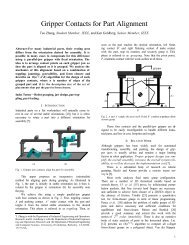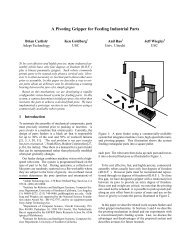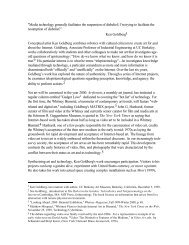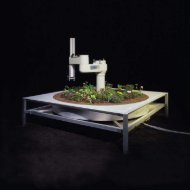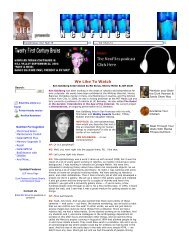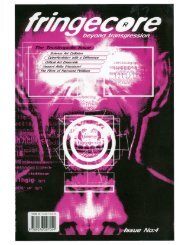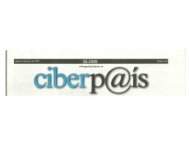0.5MB .pdf - Ken Goldberg - University of California, Berkeley
0.5MB .pdf - Ken Goldberg - University of California, Berkeley
0.5MB .pdf - Ken Goldberg - University of California, Berkeley
Create successful ePaper yourself
Turn your PDF publications into a flip-book with our unique Google optimized e-Paper software.
1370 THE INTERNATIONAL JOURNAL OF ROBOTICS RESEARCH / November/December 2008<br />
Fig. 6. Optimal plans demonstrate the importance <strong>of</strong> considering uncertainty in needle motion, where i and r are the standard<br />
deviations <strong>of</strong> needle tip deflections that can occur during insertion and direction changes, respectively. For higher r relative<br />
to i, the optimal plan includes fewer direction changes. Needle motion uncertainty at locations <strong>of</strong> direction changes may be<br />
substantially higher than uncertainty during insertion due to transverse stiffness <strong>of</strong> the needle. (a) Low uncertainty at direction<br />
changes ( i 5 , r 5 ), ps 9898%. (b) Medium uncertainty at direction changes ( i 5 , r 10 ), ps 9287%. (c)<br />
High uncertainty at direction changes ( i 5 , r 20 ), ps 7300%.<br />
Fig. 7. The optimal needle insertion location y, angle , and bevel direction b are found by scanning the DP look-up table for the<br />
feasible start state with maximal ps. Here we plot optimization surfaces for b 0. The low regions correspond to states from<br />
which the needle has a high probability <strong>of</strong> colliding with an obstacle or exiting the workspace, and the high regions correspond<br />
to better start states. (a) Optimization surface for Figure 5(c). (b) Optimization surface for Figure 6(c).<br />
we believe minutes <strong>of</strong> computation time is reasonable for the<br />
intended applications. Intra-operative computation time is effectively<br />
instantaneous since only a memory access to the DP<br />
look-up table is required to retrieve the optimal action after the<br />
needle has been localized in imaging.<br />
Integrating intra-operative medical imaging with the precomputed<br />
DP look-up table could permit optimal steering <strong>of</strong><br />
the needle in the operating room without requiring costly intraoperative<br />
re-planning. We demonstrate the potential <strong>of</strong> this approach<br />
using simulation <strong>of</strong> needle deflections based on normal<br />
distributions with mean zero and standard deviations i 5 <br />
and r 20 in Figure 9. After each insertion distance , we<br />
assume the needle tip is localized in the image. Based on the<br />
DP look-up table, the needle is either inserted or the bevel direction<br />
is changed. The effect <strong>of</strong> uncertainty can be seen as<br />
deflections in the path, that is, locations where the tangent <strong>of</strong><br />
the path abruptly changes. Since r i, deflections are more<br />
likely to occur at points <strong>of</strong> direction change. In practice, clinicians<br />
could monitor ps, insertion length and self-intersection<br />
while performing needle insertion.<br />
6. Conclusion and Future Work<br />
Downloaded from<br />
http://ijr.sagepub.com at UNIV CALIFORNIA BERKELEY LIB on November 25, 2008<br />
We developed a new motion planning approach for steering<br />
flexible needles through s<strong>of</strong>t tissue that explicitly considers uncertainty:<br />
the planner computes optimal actions to maximize



